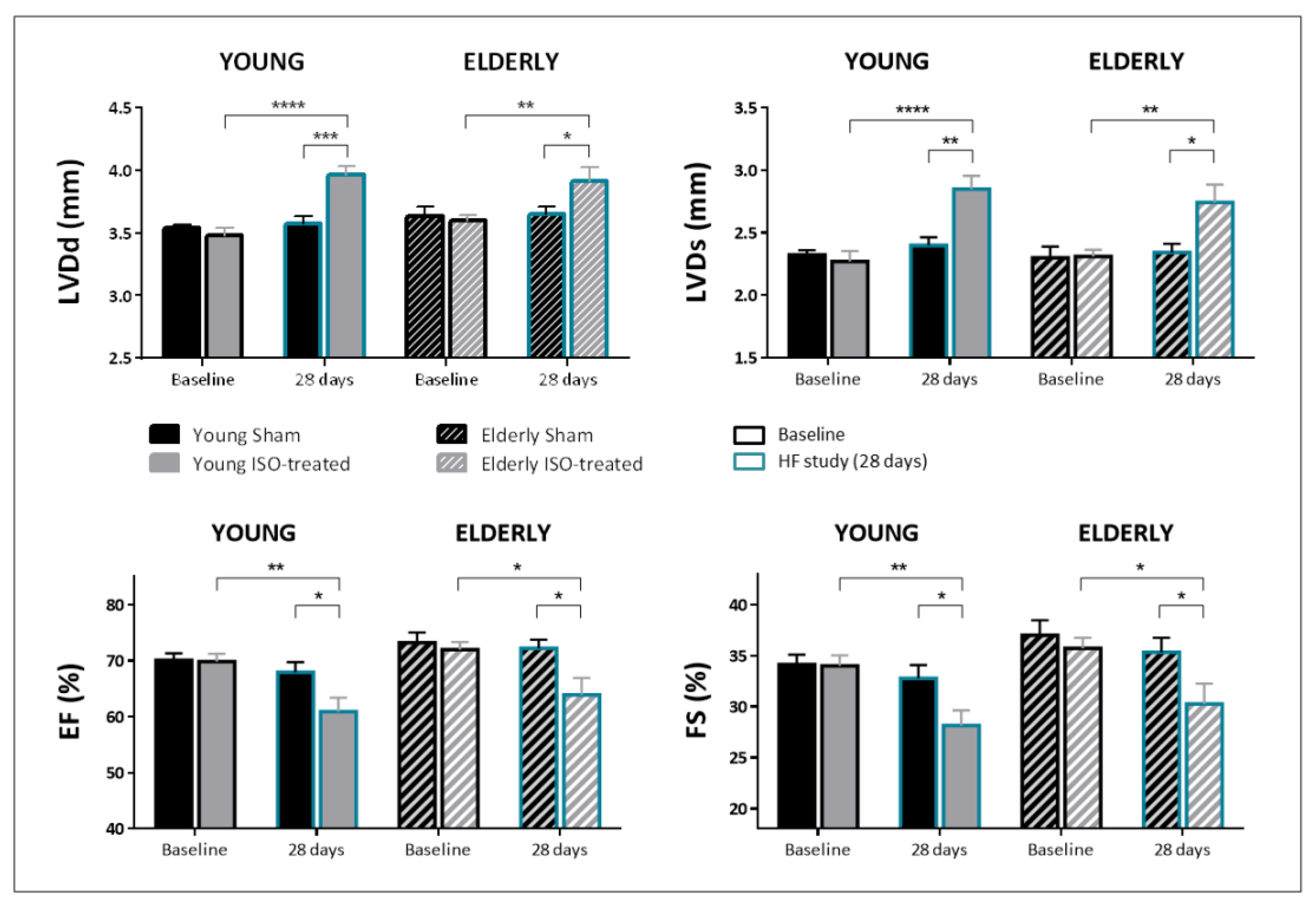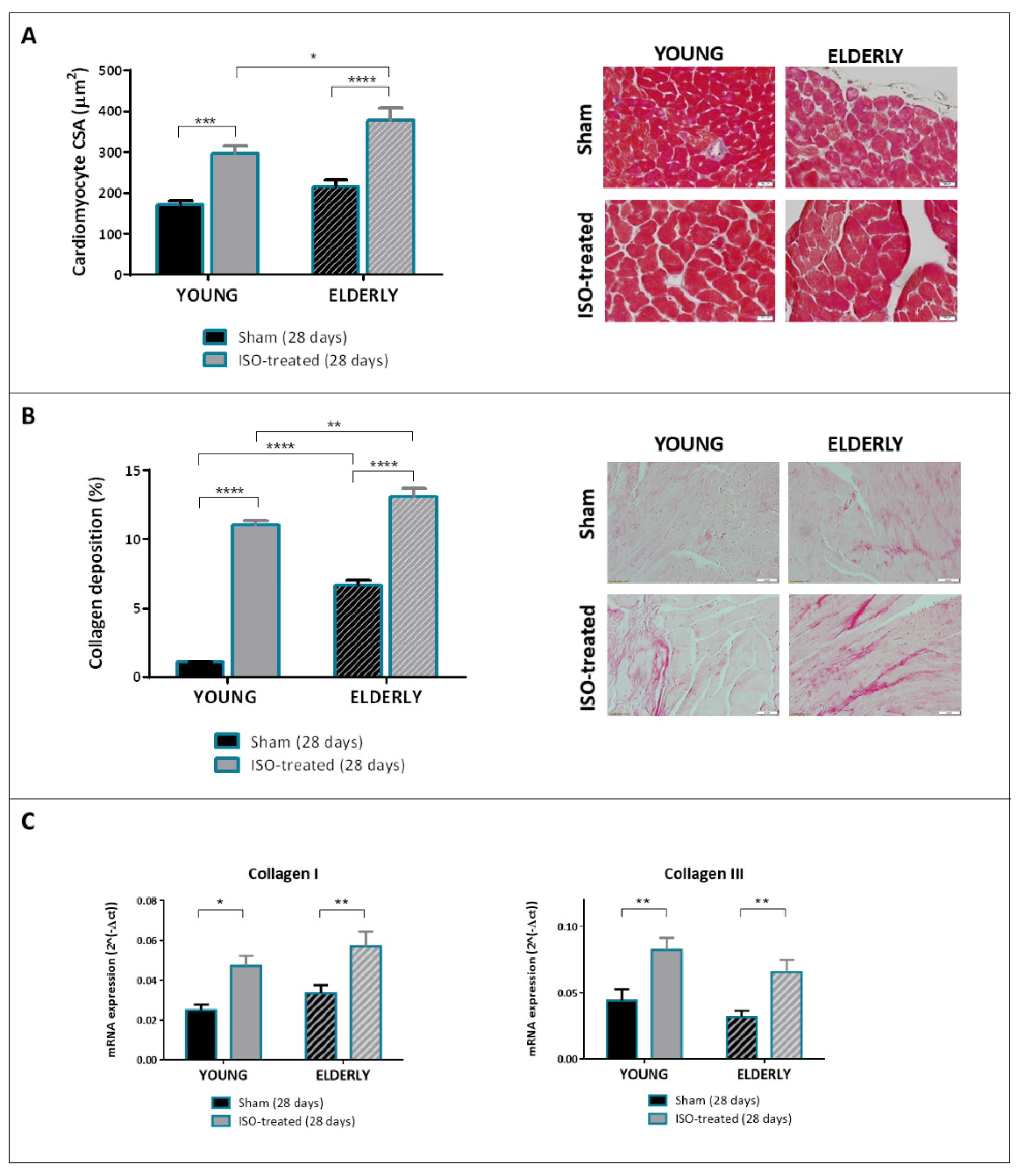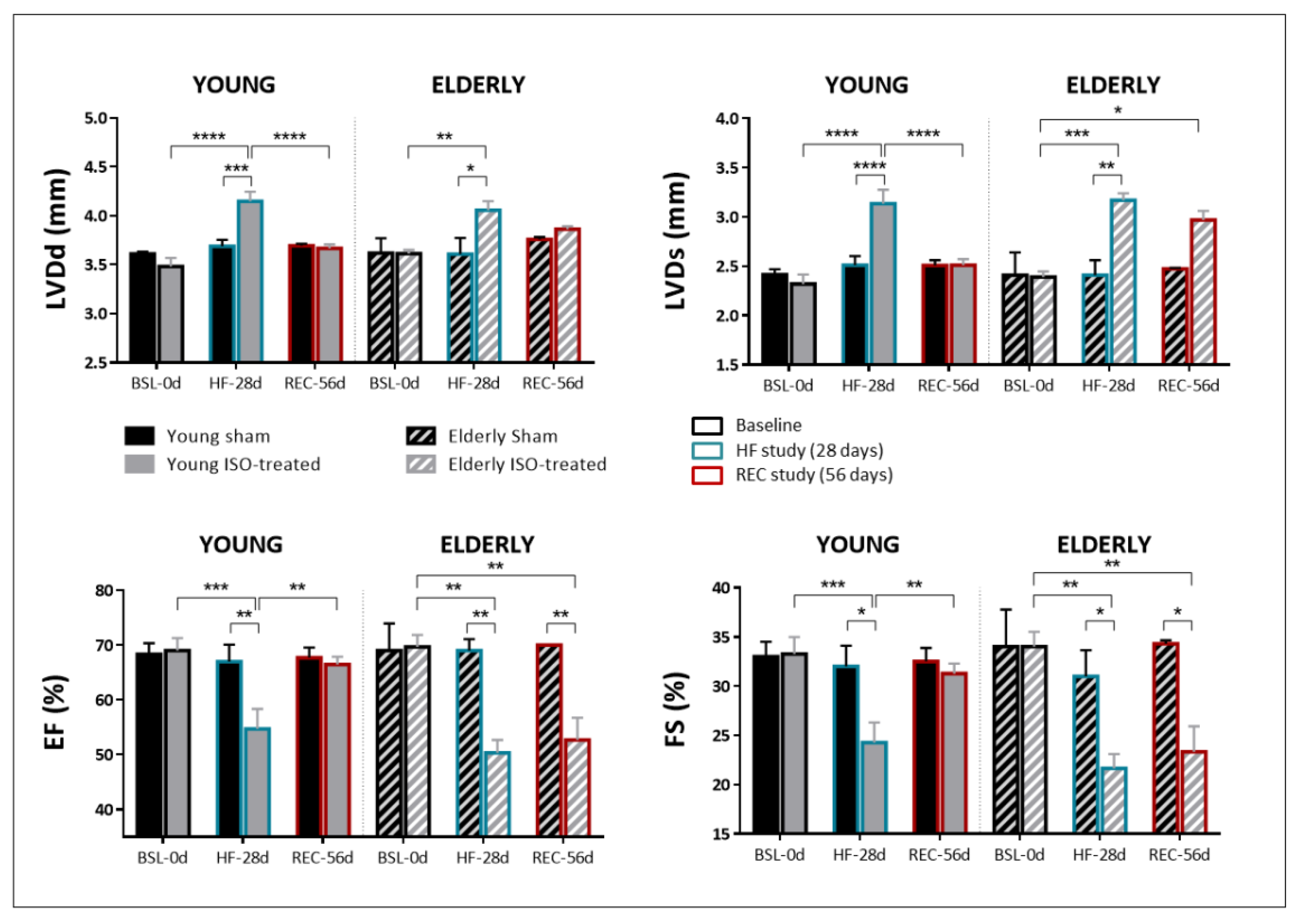Aging Impairs Reverse Remodeling and Recovery of Ventricular Function after Isoproterenol-Induced Cardiomyopathy
Abstract
1. Introduction
2. Results
2.1. Isoproterenol Infusion Induces HF with Subtle Particularities in Elderly Female Mice
2.2. Reverse Remodeling Is Distinctly Different in Young and Elderly Female Mice
3. Discussion
4. Materials and Methods
4.1. Animals
4.2. Study Design
4.3. Echocardiography
4.4. Histology
4.5. Real-Time PCR
4.6. Statistical Analyses
5. Conclusions
Author Contributions
Funding
Institutional Review Board Statement
Informed Consent Statement
Data Availability Statement
Acknowledgments
Conflicts of Interest
References
- Ziaeian, B.; Fonarow, B.Z.G.C. Epidemiology and aetiology of heart failure. Nat. Rev. Cardiol. 2016, 13, 368–378. [Google Scholar] [CrossRef] [PubMed]
- Redfield, M.M.; Jacobsen, S.J.; Burnett, J.C.; Mahoney, D.W.; Bailey, K.R.; Rodeheffer, R.J. Burden of Systolic and Diastolic Ventricular Dysfunction in the Community. JAMA 2003, 289, 194–202. [Google Scholar] [CrossRef] [PubMed]
- Farré, N.; Vela, E.; Clèries, M.; Bustins, M.; Cainzos-Achirica, M.; Enjuanes, C.; Moliner, P.; Ruiz, S.; Rotellar, J.M.V.; Comín-Colet, J. Real world heart failure epidemiology and outcome: A population-based analysis of 88,195 patients. PLoS ONE 2017, 12, e0172745. [Google Scholar] [CrossRef]
- Lupón, J.; Díez-López, C.; De Antonio, M.; Domingo, M.; Zamora, E.; Moliner, P.; González, B.; Santesmases, J.; Troya, M.I.; Bayés-Genís, A. Recovered heart failure with reduced ejection fraction and outcomes: A prospective study. Eur. J. Hearth Fail. 2017, 19, 1615–1623. [Google Scholar] [CrossRef]
- Kim, G.; Uriel, N.; Burkhoff, D. Reverse remodelling and myocardial recovery in heart failure. Nat. Rev. Cardiol. 2018, 15, 83–96. [Google Scholar] [CrossRef] [PubMed]
- Strait, J.B.; Lakatta, E.G. Aging-Associated Cardiovascular Changes and Their Relationship to Heart Failure. Heart Fail. Clin. 2012, 8, 143–164. [Google Scholar] [CrossRef] [PubMed]
- Sessions, A.O.; Engler, A.J. Mechanical Regulation of Cardiac Aging in Model Systems. Circ. Res. 2016, 118, 1553–1562. [Google Scholar] [CrossRef]
- Sciomer, S.; Moscucci, F.; Salvioni, E.; Marchese, G.; Bussotti, M.; Corrà, U.; Piepoli, M.F. Role of gender, age and BMI in prognosis of heart failure. Eur. J. Prev. Cardiol. 2020, 27, 46–51. [Google Scholar] [CrossRef]
- Crousillat, D.R.; Ibrahim, N.E. Sex Differences in the Management of Advanced Heart Failure. Curr. Treat. Options Cardiovasc. Med. 2018, 20, 1–14. [Google Scholar] [CrossRef]
- Gürgöze, M.T.; van der Galiën, O.P.; Limpens, M.A.; Roest, S.; Hoekstra, R.C.; Ijpma, A.S.; Brugts, J.J.; Manintveld, O.C.; Boersma, E. Impact of sex differences in co-morbidities and medication adherence on outcome in 25,776 heart failure patients. ESC Hearth Fail. 2021, 8, 63–73. [Google Scholar] [CrossRef]
- Rich, M.W.; Chyun, D.A.; Skolnick, A.H.; Alexander, K.P.; Forman, D.E.; Kitzman, D.W.; Maurer, M.S.; McClurken, J.B.; Resnick, B.M.; Shen, W.K.; et al. Knowledge Gaps in Cardiovascular Care of the Older Adult Population. Circulation 2016, 133, 2103–2122. [Google Scholar] [CrossRef]
- Mentzer, G.; Hsich, E.M. Heart Failure with Reduced Ejection Fraction in Women: Epidemiology, Outcomes, and Treatment. Hearth Fail. Clin. 2019, 15, 19–27. [Google Scholar] [CrossRef]
- Grilo, G.A.; Shaver, P.R.; Stoffel, H.J.; Morrow, C.A.; Johnson, O.T.; Iyer, R.P.; Brás, L.E.D.C. Age- and sex-dependent differences in extracellular matrix metabolism associate with cardiac functional and structural changes. J. Mol. Cell. Cardiol. 2020, 139, 62–74. [Google Scholar] [CrossRef] [PubMed]
- Ramirez, F.D.; Motazedian, P.; Jung, R.G.; Di Santo, P.; MacDonald, Z.; Simard, T.; Clancy, A.A.; Russo, J.J.; Welch, V.; Wells, G.A.; et al. Sex Bias Is Increasingly Prevalent in Preclinical Cardiovascular Research: Implications for Translational Medicine and Health Equity for Women: A Systematic Assessment of Leading Cardiovascular Journals Over a 10-Year Period. Circulation 2017, 135, 625–626. [Google Scholar] [CrossRef] [PubMed]
- Clayton, J.A.; Collins, F.S. Policy: NIH to balance sex in cell and animal studies. Nat. Cell Biol. 2014, 509, 282–283. [Google Scholar] [CrossRef] [PubMed]
- Castro-Grattoni, A.L.; Alvarez-Buvé, R.; Torres, M.; Farre, R.; Montserrat, J.M.; Dalmases, M.; Almendros, I.; Barbé, F.; Sánchez-De-La-Torre, M. Intermittent Hypoxia-Induced Cardiovascular Remodeling Is Reversed by Normoxia in a Mouse Model of Sleep Apnea. Chest 2016, 149, 1400–1408. [Google Scholar] [CrossRef] [PubMed]
- Chioncel, O.; Lainscak, M.; Seferovic, P.M.; Anker, S.D.; Crespo-Leiro, M.G.; Harjola, V.-P.; Parissis, J.; Laroche, C.; Piepoli, M.F.; Fonseca, C.; et al. Epidemiology and one-year outcomes in patients with chronic heart failure and preserved, mid-range and reduced ejection fraction: An analysis of the ESC Heart Failure Long-Term Registry. Eur. J. Hearth Fail. 2017, 19, 1574–1585. [Google Scholar] [CrossRef]
- Meta-analysis Global Group in Chronic Heart Failure (MAGGIC) The survival of patients with heart failure with preserved or reduced left ventricular ejection fraction: An individual patient data meta-analysis. Eur. Hearth J. 2012, 33, 1750–1757. [CrossRef]
- Chang, S.C.; Ren, S.; Rau, C.D.; Wang, J.J. Isoproterenol-Induced Heart Failure Mouse Model Using Osmotic Pump Implantation. In Springer Protocols Handbooks; Springer: Singapore, 2018; Volume 1816, pp. 207–220. [Google Scholar]
- Grimm, D.; Elsner, D.; Schunkert, H.; Pfeifer, M.; Griese, D.; Bruckschlegel, G.; Muders, F.; Riegger, G.A.; Kromer, E.P. Development of heart failure following isoproterenol administration in the rat: Role of the renin–angiotensin system. Cardiovasc. Res. 1998, 37, 91–100. [Google Scholar] [CrossRef]
- Wang, J.J.-C.; Rau, C.; Avetisyan, R.; Ren, S.; Romay, M.C.; Stolin, G.; Gong, K.W.; Wang, Y.; Lusis, A.J. Genetic Dissection of Cardiac Remodeling in an Isoproterenol-Induced Heart Failure Mouse Model. PLoS Genet. 2016, 12, e1006038. [Google Scholar] [CrossRef] [PubMed]
- Tripathi, R.; Sullivan, R.; Fan, T.-H.M.; Wang, D.; Sun, Y.; Reed, G.L.; Gladysheva, I.P. Enhanced heart failure, mortality and renin activation in female mice with experimental dilated cardiomyopathy. PLoS ONE 2017, 12, e0189315. [Google Scholar] [CrossRef]
- Bacmeister, L.; Schwarzl, M.; Warnke, S.; Stoffers, B.; Blankenberg, S.; Westermann, D.; Lindner, D. Inflammation and fibrosis in murine models of heart failure. Basic Res. Cardiol. 2019, 114, 19. [Google Scholar] [CrossRef]
- Masson, S.; Arosio, B.; Fiordaliso, F.; Gagliano, N.; Calvillo, L.; Santambrogio, D.; D’Aquila, S.; Vergani, C.; Latini, R.; Annoni, G. Left ventricular response to beta-adrenergic stimulation in aging rats. J. Gerontol. Ser. A Boil. Sci. Med Sci. 2000, 55, 35. [Google Scholar]
- De Lucia, C.; Eguchi, A.; Koch, W.J. New Insights in Cardiac β-Adrenergic Signaling During Heart Failure and Aging. Front. Pharmacol. 2018, 9, 904. [Google Scholar] [CrossRef]
- Lindenfeld, J.; Cleveland, J.C.; Kao, D.P.; White, M.; Wichman, S.; Bristow, J.C.; Peterson, V.; Rodegheri-Brito, J.; Korst, A.; Blain-Nelson, P.; et al. Sex-related differences in age-associated downregulation of human ventricular myocardial β1-adrenergic receptors. J. Hearth Lung Transplant. 2016, 35, 352–361. [Google Scholar] [CrossRef]
- Mays, P.K.; Bishop, J.E.; Laurent, G.J. Age-related changes in the proportion of types I and III collagen. Mech. Ageing Dev. 1988, 45, 203–212. [Google Scholar] [CrossRef]
- Querejeta, R.; López, B.; Gonzalez, A.; Sánchez, E.; Larman, M.; Ubago, J.L.M.; Díez, J. Increased Collagen Type I Synthesis in Patients with Heart Failure of Hypertensive Origin. Relation to myocardial fibrosis. Circulation 2004, 110, 1263–1268. [Google Scholar] [CrossRef]
- Norton, G.; Tsotetsi, J.; Trifunovic, B.; Hartford, C.; Candy, G.P.; Woodiwiss, A.J. Myocardial Stiffness Is Attributed to Alterations in Cross-Linked Collagen Rather Than Total Collagen or Phenotypes in Spontaneously Hypertensive Rats. Circulation 1997, 96, 1991–1998. [Google Scholar] [CrossRef]
- Koitabashi, N.; Kass, D.A. Reverse remodeling in heart failure—Mechanisms and therapeutic opportunities. Nat. Rev. Cardiol. 2011, 9, 147–157. [Google Scholar] [CrossRef]
- Yokokawa, M.; Good, E.; Crawford, T.; Chugh, A.; Pelosi, F.; Latchamsetty, R.; Jongnarangsin, K.; Armstrong, W.; Ghanbari, H.; Oral, H.; et al. Recovery from left ventricular dysfunction after ablation of frequent premature ventricular complexes. Hearth Rhythm. 2013, 10, 172–175. [Google Scholar] [CrossRef]
- Berruezo, A.; Penela, D.; Jáuregui, B.; Soto-Iglesias, D.; Aguinaga, L.; Ordóñez, A.; Fernández-Armenta, J.; Martínez, M.; Tercedor, L.; Bisbal, F.; et al. Mortality and morbidity reduction after frequent premature ventricular complexes ablation in patients with left ventricular systolic dysfunction. Europeace 2019, 21, 1079–1087. [Google Scholar] [CrossRef]
- Wever-Pinzon, O.; Drakos, S.G.; McKellar, S.H.; Horne, B.D.; Caine, W.T.; Kfoury, A.G.; Li, D.Y.; Fang, J.C.; Stehlik, J.; Selzman, C.H. Cardiac Recovery During Long-Term Left Ventricular Assist Device Support. J. Am. Coll. Cardiol. 2016, 68, 1540–1553. [Google Scholar] [CrossRef]
- Cheng, Y.-J.; Zhang, J.; Li, W.-J.; Lin, X.-X.; Zeng, W.-T.; Tang, K.; Tang, A.-L.; He, J.-G.; Xu, Q.; Mei, M.-Y.; et al. More Favorable Response to Cardiac Resynchronization Therapy in Women Than in Men. Circ. Arrhythmia Electrophysiol. 2014, 7, 807–815. [Google Scholar] [CrossRef]
- Cioffi, G.; Tarantini, L.; De Feo, S.; Pulignano, G.; Del Sindaco, D.; Stefenelli, C.; Opasich, C. Pharmacological left ventricular reverse remodeling in elderly patients receiving optimal therapy for chronic heart failure. Eur. J. Hearth Fail. 2005, 7, 1040–1048. [Google Scholar] [CrossRef] [PubMed][Green Version]
- Palazzuoli, A.; Bruni, F.; Puccetti, L.; Pastorelli, M.; Angori, P.; Pasqui, A.; Auteri, A. Effects of carvedilol on left ventricular remodeling and systolic function in elderly patients with heart failure. Eur. J. Hearth Fail. 2002, 4, 765–770. [Google Scholar] [CrossRef]
- Yokoyama, H.; Shishido, K.; Tobita, K.; Moriyama, N.; Murakami, M.; Saito, S. Impact of age on mid-term clinical outcomes and left ventricular reverse remodeling after cardiac resynchronization therapy. J. Cardiol. 2021, 77, 254–262. [Google Scholar] [CrossRef] [PubMed]
- Lee, A.; Denman, R.; Haqqani, H.M. Ventricular Ectopy in the Context of Left Ventricular Systolic Dysfunction: Risk Factors and Outcomes Following Catheter Ablation. Hearth Lung Circ. 2019, 28, 379–388. [Google Scholar] [CrossRef] [PubMed]
- Brinton, R.D. Minireview: Translational Animal Models of Human Menopause: Challenges and Emerging Opportunities. J. Endocrinol. 2012, 153, 3571–3578. [Google Scholar] [CrossRef] [PubMed]
- Lattouf, R.; Younes, R.; Lutomski, D.; Naaman, N.; Godeau, G.; Senni, K.; Changotade, S. Picrosirius Red Staining: A useful tool to appraise collagen networks in normal and pathological tissues. J. Histochem. Cytochem. 2014, 62, 751–758. [Google Scholar] [CrossRef]
- Livak, K.J.; Schmittgen, T.D. Analysis of relative gene expression data using real-time quantitative PCR and the 2−ΔΔCT method. Methods 2001, 25, 402–408. [Google Scholar] [CrossRef]




Publisher’s Note: MDPI stays neutral with regard to jurisdictional claims in published maps and institutional affiliations. |
© 2021 by the authors. Licensee MDPI, Basel, Switzerland. This article is an open access article distributed under the terms and conditions of the Creative Commons Attribution (CC BY) license (https://creativecommons.org/licenses/by/4.0/).
Share and Cite
Yáñez-Bisbe, L.; Garcia-Elias, A.; Tajes, M.; Almendros, I.; Rodríguez-Sinovas, A.; Inserte, J.; Ruiz-Meana, M.; Farré, R.; Farré, N.; Benito, B. Aging Impairs Reverse Remodeling and Recovery of Ventricular Function after Isoproterenol-Induced Cardiomyopathy. Int. J. Mol. Sci. 2022, 23, 174. https://doi.org/10.3390/ijms23010174
Yáñez-Bisbe L, Garcia-Elias A, Tajes M, Almendros I, Rodríguez-Sinovas A, Inserte J, Ruiz-Meana M, Farré R, Farré N, Benito B. Aging Impairs Reverse Remodeling and Recovery of Ventricular Function after Isoproterenol-Induced Cardiomyopathy. International Journal of Molecular Sciences. 2022; 23(1):174. https://doi.org/10.3390/ijms23010174
Chicago/Turabian StyleYáñez-Bisbe, Laia, Anna Garcia-Elias, Marta Tajes, Isaac Almendros, Antonio Rodríguez-Sinovas, Javier Inserte, Marisol Ruiz-Meana, Ramón Farré, Núria Farré, and Begoña Benito. 2022. "Aging Impairs Reverse Remodeling and Recovery of Ventricular Function after Isoproterenol-Induced Cardiomyopathy" International Journal of Molecular Sciences 23, no. 1: 174. https://doi.org/10.3390/ijms23010174
APA StyleYáñez-Bisbe, L., Garcia-Elias, A., Tajes, M., Almendros, I., Rodríguez-Sinovas, A., Inserte, J., Ruiz-Meana, M., Farré, R., Farré, N., & Benito, B. (2022). Aging Impairs Reverse Remodeling and Recovery of Ventricular Function after Isoproterenol-Induced Cardiomyopathy. International Journal of Molecular Sciences, 23(1), 174. https://doi.org/10.3390/ijms23010174






